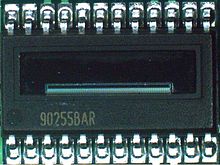Photodiode array
A photodiode line ( English photo diode array , short: PDA or diode array or linear array ) is a semiconductor component on which several photodiodes are integrated in a row on a chip together with integration and readout circuit. PDAs are therefore specialized CMOS sensors , they differ from these in principle only in the not two-dimensional, but one-dimensional arrangement of the pixels / photodiodes.
design
A line of photodiodes consists of a group of photodiodes arranged linearly (in a row) as well as a supply and readout circuit that often works with the CCD principle . The semiconductor material used for these diodes depends on the spectral sensitivity for the required wavelength range .
- UV / VIS / NIR (200–1100 nm): Si ( silicon )
- NIR / IR (900–2500 nm): InGaAs ( indium - gallium - arsenide ) or PbS ( lead sulfide )
The data is usually read out serially, depending on the type as an analog signal or as a digital signal via an internal analog-digital converter . The number of individual diodes on the chip is limited. Modern components can have 128, 256, 512 or 1024 individual elements.
There are also arrangements made with several rows of photodiodes side by side, z. B. for the simultaneous recording of reference data. Due to the limited number of individual elements, the readout time is very short (less than a millisecond), measures to ensure the stability and reproducibility of the analog measured values are complex ('dummy' or 'reference diodes', cooling and temperature control) and affect the price out.
Application in spectrometers
The photodiode arrays are usually arranged behind a polychromator and are the spatially resolving radiation detector for the spectrum. They are available for ultraviolet , visible light, and near infrared . Together with the dispersive element it forms a simultaneously-working spectrometer ( English Optical Multichannel Analyzer , OMA, or multi-channel spectrometer , MCS, called).
Spectrometers with a diode array detector are cheaper than classic, scanning spectrometers. The very fast detection of a wide range of the light spectrum is particularly advantageous. They are therefore suitable for applications in which changes must be tracked. The disadvantage is the limitation of the optical resolution due to the minimal dimensions of the individual diodes. The resolution is usually worse than with "classic" spectrometers.
Areas of application
- Diode array spectrometer
- Handheld measuring devices for color, moisture, layer thickness etc.
- Analysis technology in the laboratory, e.g. B. as a detector in liquid chromatography or HPLC
- Angle sensors
- Angle of rotation and torque sensor in electric power steering
- Optoelectronic angular position encoders , incremental encoders and absolute value encoders
- Distance measurement : devices for optical distance measurement (triangulation)
Web links
- iC-LF1401 , pin- compatible replacement type for TSL1401 from iC-Haus
- MLX90255 , automotive type with 128 pixels from Melexis NV
